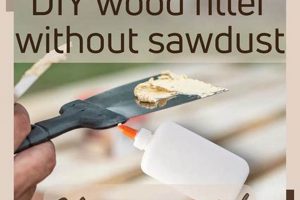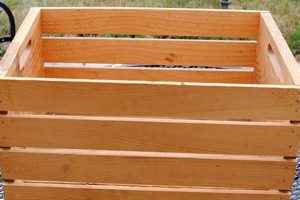The practice of creating homemade solutions for maintaining wooden surfaces is a cost-effective and environmentally conscious alternative to commercially produced products. These solutions typically employ readily available household ingredients, such as vinegar, baking soda, and essential oils, to remove dirt, grime, and minor stains from sealed hardwood and laminate floors. An example includes combining water with a small amount of vinegar to create a gentle cleaning agent.
Employing such methods offers several benefits, including reduced exposure to harsh chemicals often found in store-bought cleaners, lower costs due to the use of common and inexpensive ingredients, and the ability to tailor solutions to specific flooring needs and preferences. Historically, the formulation of cleaning solutions from natural ingredients was the primary method for household maintenance before the widespread availability of commercial products.
Subsequent sections will delve into specific formulations suitable for various wood floor types, discuss best practices for application, and provide guidance on avoiding potential damage to flooring during the cleaning process. Considerations regarding the finish and overall condition of the wood will also be addressed.
Essential Considerations for Formulating Wood Floor Cleaning Solutions
The following guidelines provide important insights into the responsible and effective use of homemade cleaning agents on wood flooring. Proper application and solution composition are crucial to maintaining the integrity of the floor’s finish and preventing damage.
Tip 1: Identify the Floor Finish. Before applying any cleaning solution, determine the type of finish on the floor (e.g., polyurethane, wax, shellac). Different finishes require specific cleaning approaches. Waxed floors, for instance, necessitate different solutions than polyurethane-coated floors.
Tip 2: Test the Solution in an Inconspicuous Area. Apply a small amount of the solution to a hidden area, such as under furniture or in a closet, and observe for any adverse reactions, such as discoloration or finish damage, before applying it to the entire floor.
Tip 3: Use Diluted Solutions. Concentrated solutions can be too harsh for wood finishes. Always dilute cleaning agents with water according to recommended ratios to minimize the risk of damage. Start with a weaker concentration and increase if necessary.
Tip 4: Avoid Excessive Moisture. Wood is susceptible to water damage. Use a damp mop or cloth, ensuring it is wrung out thoroughly to prevent water from pooling on the floor. Dry the floor immediately after cleaning with a clean, dry cloth.
Tip 5: Employ Gentle Cleaning Agents. Harsh chemicals, abrasive cleaners, and scouring pads can scratch or dull the finish of the wood. Opt for mild cleaning agents, such as diluted vinegar or castile soap, to gently lift dirt and grime.
Tip 6: Address Spills Promptly. Clean up spills immediately to prevent staining or damage to the finish. Use a soft cloth to blot the spill, avoiding rubbing, and then clean the area with the appropriate solution.
Tip 7: Consider Essential Oils for Enhanced Cleaning and Aroma. The addition of a few drops of essential oils, such as lemon or tea tree oil, can provide antibacterial benefits and a pleasant scent. Ensure the chosen oil is compatible with the floor finish.
Adhering to these precautions can help ensure the safe and effective maintenance of wood floors utilizing homemade cleaning solutions. Prioritizing gentle techniques and proper dilution is paramount to preserving the longevity and appearance of the flooring.
The subsequent sections will explore specific recipes and address common concerns related to the use of these solutions on various wood floor types.
1. Solution pH Balance
The pH of a cleaning solution directly affects its interaction with wood flooring finishes. Formulating effective and safe homemade wood floor cleaning solutions necessitates a comprehensive understanding of pH and its potential impact on various floor types. Maintaining an appropriate pH range is crucial for preserving the integrity and appearance of the wood.
- Acidic Solutions and Finish Degradation
Acidic solutions, such as those with a high concentration of vinegar, can erode certain wood floor finishes, particularly waxes and some types of varnish. Prolonged exposure to acidic cleaners can lead to dulling, discoloration, or even complete removal of the protective coating, leaving the wood vulnerable to damage. An example of this is the etching effect that undiluted vinegar can have on marble, a similar effect can occur, although slower, on sensitive wood finishes.
- Alkaline Solutions and Residue Buildup
Highly alkaline solutions, while effective at removing grease and grime, can leave a residue on wood floors. This residue can attract dirt, create a hazy appearance, and potentially damage the finish over time. Examples of alkaline ingredients that require careful usage are baking soda or borax, which, when used in excess without proper rinsing, can lead to undesirable buildup.
- Neutral pH as a Safe Option
Solutions with a near-neutral pH, typically around 7, are generally considered the safest for most wood floor finishes. These solutions are less likely to cause damage or leave behind residue. Mild dish soap diluted in water is a common example of a near-neutral cleaning agent that is often recommended for wood floors.
- pH Buffering and Solution Stability
The concept of pH buffering becomes relevant when combining different cleaning agents. A buffering agent helps maintain a stable pH level, preventing drastic shifts that could be detrimental to the floor finish. While not typically necessary for simple homemade solutions, it is a consideration when experimenting with more complex formulations.
The interaction between solution pH and wood floor finishes highlights the importance of careful ingredient selection and dilution in DIY wood floor cleaners. Selecting ingredients with a neutral pH or properly diluting acidic or alkaline substances is critical for preserving the floor’s integrity. Failure to consider pH can result in damage necessitating costly repairs or replacement.
2. Wood Finish Type
The selection of appropriate cleaning solutions is inextricably linked to the specific finish applied to a wood floor. Wood floor finishes, which may include polyurethane, varnish, shellac, wax, or penetrating oil, dictate the chemical compatibility of cleaning agents. Incompatibility between the cleaning solution and the finish can result in damage ranging from dulling and discoloration to complete removal of the protective layer. For example, using an alkaline solution on a waxed floor can dissolve the wax, leaving the wood unprotected and vulnerable to moisture damage. Conversely, a finish such as polyurethane is generally more resilient and can withstand a wider range of cleaning solutions, though harsh chemicals should still be avoided. Determining the finish type is therefore the initial and most critical step in the solution selection process.
Practical application of this understanding involves carefully examining the floor to identify its finish. A water test, where a small amount of water is left on the floor for a short period, can provide clues. If the water beads up, the finish is likely a surface finish like polyurethane. If the water soaks in, the finish is likely a penetrating oil or wax. Furthermore, older floors may have multiple layers of different finishes applied over time, making identification more challenging. In these cases, consulting with a flooring professional may be necessary to accurately determine the finish type and recommend appropriate cleaning solutions. The consequences of misidentification and subsequent use of an incompatible cleaning agent can lead to costly repairs or even complete floor replacement.
In summary, the relationship between wood finish type and the selection of cleaning solutions is a fundamental aspect of wood floor maintenance. Ignoring this connection can lead to irreversible damage and necessitate expensive restoration efforts. By correctly identifying the finish and choosing cleaning agents accordingly, the longevity and aesthetic appeal of wood floors can be preserved. Challenges in identification, particularly with older or multi-layered finishes, should be addressed by seeking expert advice to ensure proper cleaning practices.
3. Moisture Control
Effective wood floor maintenance using homemade solutions necessitates stringent moisture control measures. Excess moisture, a primary cause of damage to wood flooring, can lead to warping, swelling, discoloration, and the promotion of mold growth. The formulation and application of “wood floor cleaner diy” recipes must, therefore, prioritize minimal water usage. For instance, a solution applied too liberally, or inadequately wrung out, can seep into the seams between planks, causing expansion and subsequent buckling. This effect is particularly pronounced in engineered wood floors, where the veneer layer is susceptible to detachment from the core material due to moisture infiltration.
Practical application of moisture control within “wood floor cleaner diy” protocols involves several techniques. The use of a microfiber mop, known for its superior liquid absorption, is recommended. Furthermore, the mop should be wrung out thoroughly before each application, ensuring it is damp rather than wet. After cleaning, the floor should be promptly dried with a clean, dry cloth to remove any remaining surface moisture. In situations where spills occur, immediate cleanup is essential to prevent prolonged water exposure. For example, in a kitchen environment where spills are common, prompt cleaning with a dry cloth followed by a slightly dampened mop can mitigate the risk of water damage. The selection of ingredients also plays a role; solutions with a higher concentration of alcohol, which evaporates more quickly than water, can reduce the risk of moisture-related issues.
In summary, moisture control is an indispensable component of “wood floor cleaner diy.” Neglecting this aspect can negate the cost-saving and environmentally friendly benefits of homemade solutions, resulting in significant and potentially irreversible damage to wood flooring. Through careful application techniques, appropriate ingredient selection, and proactive spill management, the risk of moisture-related problems can be minimized, ensuring the longevity and aesthetic appeal of the wood floor. Challenges arise in accurately assessing the moisture content of the floor and adjusting cleaning practices accordingly, highlighting the need for continuous vigilance and adaptation to environmental conditions.
4. Ingredient Compatibility
In the realm of “wood floor cleaner diy,” the principle of ingredient compatibility is paramount. It directly affects the efficacy of the cleaning solution and, more importantly, the preservation of the wood floors finish and structural integrity. The interaction between different components within a homemade cleaner can either enhance the cleaning process or initiate detrimental chemical reactions. For example, combining an acidic substance like lemon juice with an alkaline substance like baking soda can neutralize both agents, diminishing their cleaning power and potentially leaving a residue. Furthermore, certain essential oils, while beneficial for their aroma and antibacterial properties, may react negatively with specific floor finishes, causing discoloration or damage. Therefore, the selection and combination of ingredients must be carefully considered to avoid unintended adverse effects.
Understanding ingredient compatibility extends beyond simple reactions and encompasses potential long-term effects. For instance, repeatedly using a cleaner containing a solvent incompatible with the floor’s finish can gradually degrade the protective layer, exposing the wood to moisture and physical damage. Real-life examples include the use of ammonia-based cleaners on waxed floors, which can strip the wax and leave a dull, unprotected surface. Similarly, combining vinegar with certain types of metal (e.g., within the cleaning apparatus) can lead to corrosion, further complicating the cleaning process. Practical application involves researching the chemical properties of each ingredient and their potential interactions with the specific type of wood floor finish. This may entail consulting flooring manufacturers guidelines or seeking advice from professionals.
In conclusion, ingredient compatibility is a cornerstone of successful and safe “wood floor cleaner diy.” A lack of understanding in this area can lead to ineffective cleaning, surface damage, and costly repairs. Prioritizing research and careful selection of compatible ingredients is crucial for ensuring the longevity and aesthetic appeal of wood floors. Challenges arise when dealing with unknown floor finishes or complex combinations of ingredients, emphasizing the need for a cautious approach and, when necessary, expert consultation. This principle links directly to the broader theme of responsible and informed decision-making in homemade cleaning solutions, prioritizing the long-term well-being of the wood floor.
5. Proper Dilution Ratio
In the context of “wood floor cleaner diy,” the proper dilution ratio serves as a critical determinant of cleaning efficacy and the preservation of the flooring’s integrity. The concentration of the cleaning agent, dictated by the dilution ratio, directly impacts its ability to remove dirt and grime without causing damage to the wood or its finish. A solution too concentrated may strip the protective layer, leading to discoloration, dulling, or even warping of the wood. Conversely, a solution that is too diluted may prove ineffective in removing surface contaminants, resulting in a persistent buildup of dirt and a lackluster appearance. Real-life examples demonstrate the consequences of improper dilution: undiluted vinegar, often touted as a natural cleaner, can etch the finish on certain types of wood floors, while an excessively watered-down solution of castile soap may leave a sticky residue. The correct ratio, therefore, is not merely a suggestion but a fundamental component of any successful homemade wood floor cleaning protocol.
The practical application of this understanding involves careful adherence to recommended dilution guidelines for each specific cleaning agent. These guidelines often vary based on the type of wood floor finish (e.g., polyurethane, wax, oil) and the severity of the cleaning task. For routine cleaning, a more diluted solution is typically sufficient, while heavier soiling may necessitate a slightly more concentrated mixture, always erring on the side of caution. Furthermore, the type of water used for dilution can also influence the outcome. Hard water, with its high mineral content, may interfere with the cleaning agent’s effectiveness, potentially requiring a slightly adjusted ratio or the use of distilled water. Regular assessment of the floor’s condition after cleaning can provide valuable feedback on the appropriateness of the dilution ratio, allowing for adjustments as needed.
In conclusion, the proper dilution ratio is inextricably linked to the success and safety of “wood floor cleaner diy.” Its importance stems from its direct impact on both the cleaning performance and the long-term preservation of wood floors. Challenges in determining the ideal ratio often arise due to variations in wood floor finishes, water quality, and the specific cleaning agent used. However, by prioritizing adherence to recommended guidelines, careful observation, and adaptive adjustments, these challenges can be effectively addressed. This principle ties directly to the broader theme of informed decision-making and responsible resource utilization within the realm of DIY household maintenance, ensuring that homemade solutions contribute to the longevity and aesthetic appeal of wood floors.
6. Gentle Application
Gentle application techniques are an indispensable component of successful “wood floor cleaner diy,” directly influencing the outcome of the cleaning process and the long-term preservation of the wood’s integrity. The forceful or abrasive application of cleaning solutions can cause physical damage to the floor’s finish, leading to scratches, dulling, or even the complete removal of the protective coating. This risk is amplified when using homemade solutions, as the chemical composition may not be as precisely controlled as in commercially manufactured products. A real-life instance of this effect is observed when abrasive scrubbing pads are used in conjunction with a “wood floor cleaner diy” solution containing even mild abrasives; the scrubbing action exacerbates the abrasive effects, causing microscopic scratches that accumulate over time, leading to a hazy appearance. The importance of gentle application, therefore, lies in mitigating the risk of physical damage while still effectively removing dirt and grime.
Practical application of gentle cleaning methods within the “wood floor cleaner diy” context involves several key techniques. The use of soft microfiber mops or cloths is essential to avoid scratching the floor’s surface. These materials are designed to trap dirt and debris without the need for excessive pressure. Circular motions and heavy scrubbing must be avoided in favor of light, overlapping strokes that evenly distribute the cleaning solution. Furthermore, the amount of pressure applied should be minimal, allowing the cleaning solution to do the work rather than relying on physical force. The implementation of a two-bucket system, where one bucket contains the cleaning solution and the other contains clean water for rinsing the mop, further enhances the gentle application process by preventing the reintroduction of dirt onto the floor. Proper rinsing after cleaning is also crucial to remove any remaining cleaning solution, which could potentially damage the finish over time if left to dry on the surface.
In conclusion, gentle application techniques are a cornerstone of effective and safe “wood floor cleaner diy.” The adoption of these techniques is crucial for preserving the beauty and extending the lifespan of wood floors. Challenges in achieving consistently gentle application arise from variations in floor types, cleaning solutions, and individual user habits. However, by prioritizing soft materials, light pressure, and proper rinsing, these challenges can be effectively addressed. This principle directly relates to the broader theme of responsible and informed decision-making within DIY household maintenance, ensuring that homemade solutions contribute to the longevity and aesthetic appeal of wood floors without causing unintended harm.
7. Spot Testing
Spot testing represents a critical preventative measure within the realm of “wood floor cleaner diy.” It directly addresses the inherent risks associated with applying untested homemade cleaning solutions to an entire wood floor surface. The primary cause of damage from DIY cleaning agents stems from the variable and often unknown reactions between solution ingredients and the specific wood floor finish. Spot testing mitigates this risk by allowing observation of any adverse effects discoloration, finish damage, or residue formation in a small, inconspicuous area before widespread application. For example, a solution containing lemon juice, even when diluted, may cause bleaching on certain dark-stained wood floors. Spot testing in a closet or under a piece of furniture would reveal this potential issue before it affects the visible floor area. Therefore, spot testing serves as a crucial safeguard against irreversible damage that could necessitate costly repairs or refinishing.
Practical significance lies in the standardized approach to implementing spot testing. Select an area, ideally hidden from view, and apply a small amount of the “wood floor cleaner diy” solution. Allow the solution to dwell for the recommended cleaning duration, then thoroughly remove it. Observe the area over a period of 24 to 48 hours, noting any changes in color, texture, or finish integrity. If any adverse effects are observed, the solution should not be used on the remainder of the floor. Adjustments to the formula, such as further dilution or the removal of potentially reactive ingredients, can then be made before retesting. The absence of any negative effects during spot testing does not guarantee complete safety, but it significantly reduces the likelihood of widespread damage. For instance, a seemingly compatible solution might cause issues only after repeated applications; therefore, continuous monitoring of the floor’s condition is still necessary.
In summary, spot testing constitutes an indispensable step in “wood floor cleaner diy,” providing a means to assess the compatibility of homemade cleaning solutions with specific wood floor finishes. The primary challenge lies in accurately interpreting the results of the spot test and distinguishing minor, acceptable changes from potentially damaging reactions. However, by adhering to a standardized procedure and diligently monitoring the tested area, the risks associated with DIY cleaning agents can be significantly minimized. This practice underscores the broader theme of responsible and informed decision-making in household maintenance, prioritizing the preservation of valuable assets and preventing avoidable expenses.
Frequently Asked Questions about Wood Floor Cleaner DIY
The following questions and answers address common concerns and misconceptions associated with creating homemade wood floor cleaning solutions. The information presented aims to provide clarity and guidance for maintaining wood floors effectively and safely using DIY methods.
Question 1: Can vinegar be safely used on all wood floors?
Vinegar, while a common ingredient in homemade cleaners, possesses acidic properties that can damage certain wood floor finishes, particularly wax and shellac. Its use is generally considered safe on polyurethane-finished floors when diluted appropriately (typically no more than 1/2 cup of white vinegar per gallon of water). Prior to applying vinegar solutions, identifying the specific floor finish and conducting a spot test in an inconspicuous area are critical steps.
Question 2: Are essential oils beneficial for wood floor cleaning?
Certain essential oils, such as tea tree or lemon oil, possess antimicrobial properties and can impart a pleasant scent. However, the direct application of undiluted essential oils can potentially damage wood floor finishes. Diluting a few drops of essential oil in a carrier solution, such as water and vinegar or castile soap, is recommended. Careful consideration should be given to the specific oil’s compatibility with the floor finish.
Question 3: How can residue buildup from homemade wood floor cleaners be prevented?
Residue buildup often results from using excessive amounts of soap or other cleaning agents. Employing diluted solutions and thoroughly rinsing the floor with clean water after cleaning can mitigate this issue. Avoid using products containing waxes or oils, as these can contribute to residue accumulation over time. Periodic cleaning with a pH-neutral cleaner can also help remove existing residue.
Question 4: What is the best method for drying wood floors after cleaning with a DIY solution?
Prompt and thorough drying is essential to prevent water damage to wood floors. Using a clean, dry microfiber cloth or mop to absorb excess moisture immediately after cleaning is recommended. Ensuring adequate ventilation in the room can also accelerate the drying process. Avoid leaving standing water on the floor for any extended period.
Question 5: Can baking soda be used to remove stains from wood floors?
Baking soda possesses mild abrasive properties and can be used to remove certain types of stains from wood floors. However, its use requires caution, as excessive scrubbing can damage the finish. Creating a paste of baking soda and water, applying it to the stain, and gently rubbing with a soft cloth is the recommended approach. Thoroughly rinsing the area afterward is crucial to remove any remaining residue.
Question 6: Are steam mops safe for cleaning wood floors?
The use of steam mops on wood floors is a subject of debate. While some manufacturers claim their steam mops are safe for sealed wood floors, the high heat and moisture can potentially damage the finish over time. If considering a steam mop, ensure the floor is properly sealed and use the lowest steam setting. Consulting the floor manufacturer’s recommendations is advisable.
In conclusion, while creating “wood floor cleaner diy” can be a cost-effective and environmentally conscious approach to maintenance, careful consideration of the ingredients, application methods, and the specific characteristics of the wood floor is essential for preventing damage and ensuring optimal cleaning results.
The following sections will explore advanced techniques and address specialized cleaning scenarios for wood floors.
Wood Floor Cleaner DIY
The preceding sections have explored the nuances of formulating homemade solutions for maintaining wood floors. Emphasis has been placed on understanding the chemical interactions between cleaning agents and floor finishes, the importance of moisture control, and the necessity of employing gentle application techniques. While “wood floor cleaner diy” offers potential benefits in terms of cost savings and reduced chemical exposure, the practice demands a meticulous approach and a thorough understanding of flooring materials and cleaning principles. The inherent risks associated with improper formulations and application methods necessitate a cautious and informed approach.
Ultimately, the decision to engage in “wood floor cleaner diy” should be based on a careful assessment of one’s expertise, the value of the flooring, and the potential consequences of error. While the information presented serves as a comprehensive guide, it does not substitute for professional advice. Responsible and informed decision-making remains paramount, ensuring that the pursuit of cost-effective cleaning does not compromise the longevity and aesthetic integrity of valuable wood floor assets.







